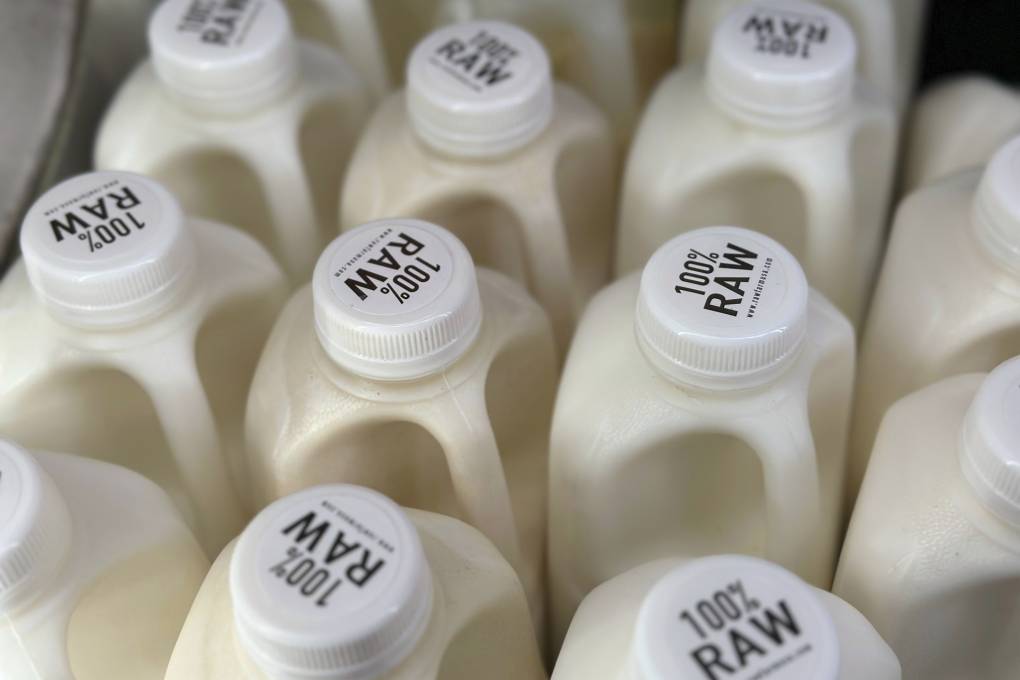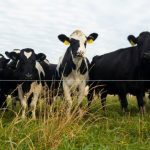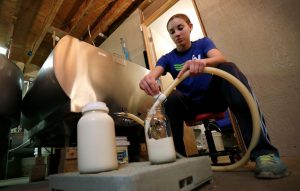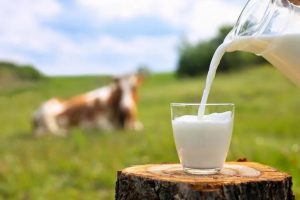
Sales of raw milk, or milk that has not undergone the heat treatment process to kill harmful bacteria, have spiked in recent weeks since the Department of Agriculture announced in March that herds of dairy cattle had been infected with the highly pathogenic avian influenza.
According to the market research firm NIQ, weekly sales of raw cow’s milk have increased by 21% since March 25 and 65% from the same period last year.
Pasteurization was invented by French scientist Louis Pasteur in the 1860s and involves heating liquids, including milk, to eliminate dangerous bacteria, such as E. coli, camplyobacter, and salmonella. The United States adopted mandatory pasteurization laws in 1924, making the process a century-old standard for the milk industry in the U.S.
But pasteurization has come under suspicion in recent years, raw milk industry leaders told the Washington Examiner, alongside a rise in skepticism of the public health agencies that promote it. The negative sentiment rose at the onset of the COVID-19 pandemic and again with the outbreak of the bird flu.
“COVID was the best thing that ever happened to raw milk,” Mark McAffee, president of the Raw Milk Institute in California, one of the 14 states where the sale of raw milk is allowed in grocery stores and the 21 states where it is allowed to be sold directly by farmers, said.
McAffee has nearly 25 years of raw milk farming experience since he took over his family farm in the 1990s. He maintains it is possible to produce raw milk that eliminates some of the risk.
He said that raw milk is tested rigorously before it is shipped. “And you do it really, really well with rapid chilling and all that kind of stuff. You produce a delicious product people just can’t get enough of,” he said
Is avian flu in raw milk?
The Food and Drug Administration has maintained that pasteurization is the primary reason why bird flu has not been a problem in the commercial milk supply, with the destruction of milk from sick cows another factor.
“The pasteurization process has served public health well for more than 100 years,” the FDA said in its press release May 10. “Even if virus is detected in raw milk, pasteurization is generally expected to eliminate pathogens to a level that does not pose a risk to consumer health.”
As of May 10, the FDA is still testing raw milk samples to quantify exactly how much of the virus infected cows are shedding into their unprocessed milk. In spite of these tests, however, the FDA and the Centers for Disease Control and Prevention strongly advise against consuming any raw milk products.
Anna Catharina Berge, a Swedish veterinarian and epidemiologist specializing in raw milk production, told the Washington Examiner that the risk of human transmission through milk is low even if live virus is found in raw milk. That is because avian flu viruses usually are spread through close contact and respiratory droplets, not food.
“When looking at avian influenza as a whole, this virus group, these viruses have never ever been involved in oral infections. They’re always just respiratory or contact infections,” Berge said. “There has never been a risk of transmission through food for any types of avian influenza identified.”
Kerry Kaylegian, associate research professor in the Food Science Department at Penn State University, told the Washington Examiner that her work focuses on educating farmers in Pennsylvania about the dangers of selling raw milk, although it is legal in the commonwealth. She says there is still much more to learn about the virus, but that doesn’t mean raw milk is safe.
“We don’t know right now how people can get infected, if people can get infected from the milk. So a lot of this is precautionary as far as the bird flu goes, but there’s always the risk of other pathogens in milk,” she said.
Milk was responsible for 25% of all disease outbreaks due to infected food and contaminated water in 1938, according to the FDA. Today, however, milk and fluid milk products account for less than 1% of such outbreaks
Conditions on the farm
Even before the bird flu outbreak, much of the debate over raw milk revolved around the cleanliness of conditions on dairy farms, with raw milk advocates highlighting the safe conditions they are legally required to uphold during every step of the process.
McAffee said that pasteurization disincentivizes industrial farmers from preventing bacteria and viruses from entering the raw milk supply in the first place because they know they will be killed in the heating process. For him, it’s a simple question of economics.
“They’re being paid so little for their milk that the standards under the Pasteurized Milk Ordinance and FDA allow anything to get in because it’s going to get pasteurized,” McAffee said of industrialized farms. “On raw milk farms, you got to be pathogen-free, clean, healthy cows. You monitor everything, but you’re being paid ten times more for the milk.”
When asked about the potentially perverse incentive of pasteurization, Kaylegian said that her experience doesn’t support it, especially since certain dairy producers will pay premiums for higher quality milk, irrespective of pasteurization.
“I think every farmer should want to treat their animals as humanely as possible and keep the barns as clean as possible,” Kaylegian said. “Keeping your animals healthy will give you the cleanest milk, the best quality milk.”
Skepticism of the American regulatory agencies
Berge and other colleagues in Europe have conducted several studies for academic journals finding significant benefits to raw milk consumption, such as decreasing allergies, asthma, eczema, and respiratory infections.
Raw milk advocates claim pasteurization alters the whey protein content of the milk, but the FDA maintains that the heating process only has a limited effect on these properties.
When asked why European scientists and regulatory agencies are more open to the debate on raw milk than the U.S., Berge said it boils down to a stark difference in food culture.
“I think that the background of Europe is somewhat different with very long historical traditions and varied food culture,” Berge said. “This is preserving our heritage. So governments do not and can not strip down our cultural heritage and identity and to eat sterile food that is deemed microbiologically safe.”
Berge also said that regulatory agencies in the U.S. “are sitting in the lap of Big Pharma and food industries,” making them more susceptible to industry persuasion than those of other countries.
“The dairy industry quickly realized that by being able to pasteurize the milk, it’s so much easier to transport, handle, sell and keep a good shelf-life by the consumer,” Berge said. “Therefore, they have no interest in seeing government funding to go into studies that show that pasteurized milk is allergenic and raw milk can be produced hygienically and safely.”
The situation in Europe, however, is a bit different in that citizens of European countries are also much more likely to trust government agencies, Berge says. She says that there “is a lot more distrust” of government in the U.S.
You can now read the most important #news on #eDairyNews #Whatsapp channels!!!
🇺🇸 eDairy News INGLÊS: https://whatsapp.com/channel/0029VaKsjzGDTkJyIN6hcP1K

























